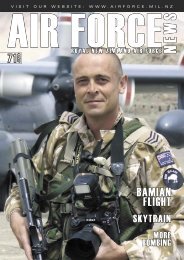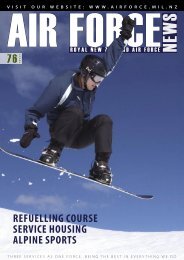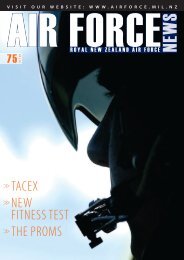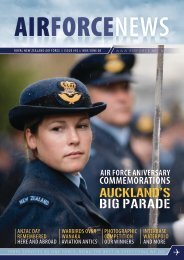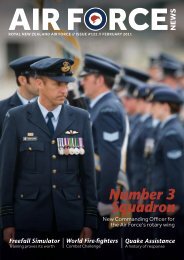ANNIVeRSARY AIR SHow! - Royal New Zealand Air Force
ANNIVeRSARY AIR SHow! - Royal New Zealand Air Force
ANNIVeRSARY AIR SHow! - Royal New Zealand Air Force
You also want an ePaper? Increase the reach of your titles
YUMPU automatically turns print PDFs into web optimized ePapers that Google loves.
operational capability<br />
TACTiCAL<br />
TEST!<br />
a series of big military transports, flying low and dropping carefully cushioned loads by<br />
parachute, is a rare sight in the auckland region. But in recent weeks, during exercise KIwI<br />
Flag, american, French, singaporean and australian transport crews joined rNZaF personnel<br />
in testing their tactical skills.<br />
dropping cargo from the back of a low flying c-130<br />
Hercules or a big c-17 for troops on the ground<br />
is a necessary skill relevant to operations in<br />
Afghanistan—and even to scientists at the South Pole (where<br />
snow conditions can prevent an aircraft landing). on this<br />
exercise, however, a variety of practice loads were dropped,<br />
ranging from large drums strapped to a pallet, to tractor tyres<br />
and water ballast.<br />
exercise kIwIFlAG 2012 was a tactical training exercise for<br />
fixed wing air transports, held at RNZAF base Auckland and<br />
conducted from 24 March to 05 April. The exercise scenario<br />
was designed to provide tactical-qualified aircrew with<br />
realistic exercises, in a deployed operational environment<br />
and emphasising coalition operations. The exercise tested<br />
intra-theatre air mobility techniques, including low level flying,<br />
simulated airdrop, cargo and personnel airdrop, and airlandings<br />
for insertion, or extraction, of personnel and cargo.<br />
The <strong>New</strong> <strong>Zealand</strong> crews came to kIwI FlAG fresh from<br />
exercise SkYTRAIN, which had been centred on the grass<br />
airfield at Alexandra during February and early March. SQN<br />
ldR Andy Scott (the detachment commander for SkYTRAIN)<br />
12 <strong>Air</strong> <strong>Force</strong> news<br />
said the earlier exercise was for ‘currency training’; keeping<br />
personnel up to date with their training targets. The exercise<br />
developed aircrew skills in map reading, low-level flying and<br />
accurate timekeeping to ensure that the parachute loads were<br />
dropped in the designated drop zone.<br />
“we also conduct training for the support trades down<br />
here such as parachute riggers and medics. on one day we did<br />
training for aero-medical evacuation flights.”<br />
The mock evacuation scenario included ‘injured’ people<br />
on the camp who had to be transported in the Hercules. This<br />
situation provided the opportunity for the medics to practice<br />
their procedures away from base in an environment that<br />
mirrors the real thing, in real time.<br />
For personnel assigned on exercise for training purposes,<br />
there’s very little downtime. It’s a gruelling day with three,<br />
three hour flights. The preparation that goes into each flight,<br />
and making sure all the training objectives are met, is immense.<br />
each flight involves the standard aircrew of a Hercules —<br />
pilot, co-pilot, engineer, navigator/air warfare officer and two<br />
loadmasters. In addition to this team, the aircraft will carry<br />
other personnel under training. overall nearly 30 flights were



![February 2007, Issue 78 [pdf 3mb, 44 pages] - Royal New Zealand ...](https://img.yumpu.com/17485296/1/184x260/february-2007-issue-78-pdf-3mb-44-pages-royal-new-zealand-.jpg?quality=85)
